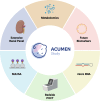Acute High Dose Melatonin for Encephalopathy of the Newborn (ACUMEN) Study: a protocol for a multicentre phase 1 safety trial of melatonin to augment therapeutic hypothermia for moderate/severe hypoxic ischaemic encephalopathy
- PMID: 40846329
- PMCID: PMC12374684
- DOI: 10.1136/bmjopen-2025-107083
Acute High Dose Melatonin for Encephalopathy of the Newborn (ACUMEN) Study: a protocol for a multicentre phase 1 safety trial of melatonin to augment therapeutic hypothermia for moderate/severe hypoxic ischaemic encephalopathy
Abstract
Introduction: Neonatal death and later disability remain common sequelae of hypoxic-ischaemic encephalopathy (HIE) despite the now standard use of therapeutic hypothermia (HT). New therapeutic approaches to brain protection are required. Melatonin is an indolamine hormone with free-radical scavenging, antiapoptotic, anti-inflammatory and gene regulatory neuroprotective properties, which has extensive preclinical evidence of safety and efficacy. Pharmacokinetic (PK) data suggest it is necessary to reach melatonin levels of 15-30 mg/L within 6-8 hours of hypoxia-ischaemia for brain protection. We developed a novel Good Manufacturing Practice (GMP) grade melatonin in ethanol 50 mg/mL solution for intravenous use. In preclinical studies, ethanol is an adjuvant excipient with additional neuroprotective benefit; optimised dosing protocols can achieve therapeutic melatonin levels while limiting blood alcohol concentrations (BACs).
Methods and analysis: The Acute High Dose Melatonin for Encephalopathy of the Newborn (ACUMEN) Study is a first-in-human, international, multicentre, phase 1 safety study of intravenous melatonin in babies with moderate/severe HIE receiving HT. Sixty babies will be studied over two phases: a dose escalation study including four dose levels to establish the recommended phase 2 dose (RP2D), followed by a 6-month cohort expansion study of RP2D to further characterise PKs and affirm safety. Participants will receive a 2-hour intravenous infusion of melatonin within 6 hours of birth, followed by five maintenance doses every 12 hours to cover the period of HT. Plasma melatonin and BACs will be monitored. The RP2D will be based on the attainment of therapeutic melatonin levels while limiting BACs and the frequency of dose-limiting events (DLEs). A Bayesian Escalation with Overdose Control approach will be used to estimate the risk of DLE per dose level, with a target level of <33%. ACUMEN will establish a network of centres with standardised neurocritical care and harmonised MRI systems for the analysis of the primary outcome-magnetic resonance spectroscopy (MRS) lactate to N-acetylaspartate peak area ratio localised to the basal ganglia and thalamus and include a nested blood biomarker study to explore early disease severity indicators.
Ethics and dissemination: Approval has been given by the London Central National Health Service Health Research Authority Ethics Committee (25/LO/0170) and UK Clinical Trials Authorisation from the Medicines and Healthcare products Regulatory Agency. Separate approvals have been sought in Ireland and Australia. Dissemination will be via peer-reviewed journals, conference presentations, public registries and plain language summaries for parent/legal guardian(s), in accordance with national requirements.
Trial registration number: ISRCTN61218504.
Eu ct: 2025-520538-49-00.
Protocol version: Publication based on the UK protocol V.3.0, 08 May 2025.
Keywords: Brain Injuries; Clinical Trial; Hypoxia; Neonatology.
© Author(s) (or their employer(s)) 2025. Re-use permitted under CC BY. Published by BMJ Group.
Conflict of interest statement
Competing interests: None declared.
Figures



References
-
- Gale C, Statnikov Y, Jawad S, et al. Neonatal brain injuries in England: population-based incidence derived from routinely recorded clinical data held in the National Neonatal Research Database. Arch Dis Child Fetal Neonatal Ed. 2018;103:F301–6. doi: 10.1136/archdischild-2017-313707. - DOI - PMC - PubMed
Publication types
MeSH terms
Substances
LinkOut - more resources
Full Text Sources
Miscellaneous
